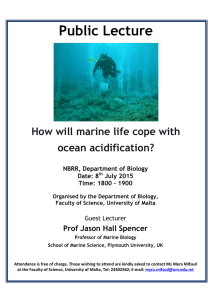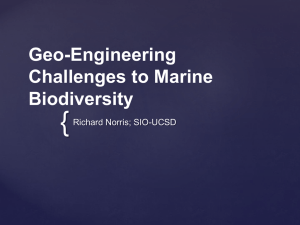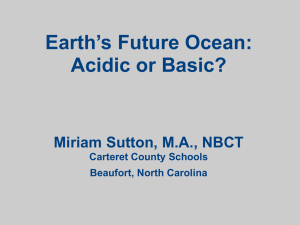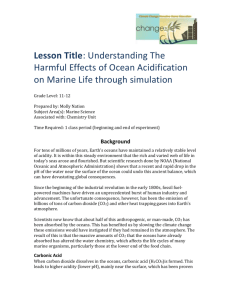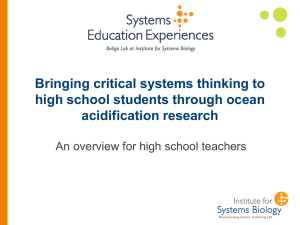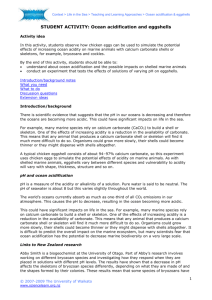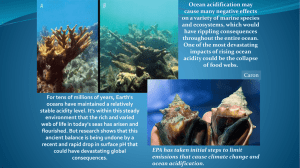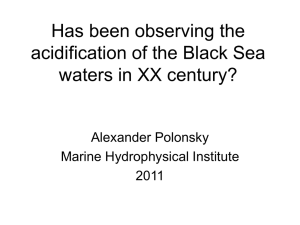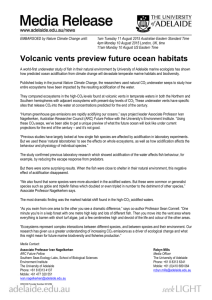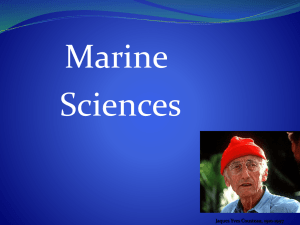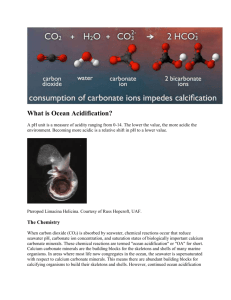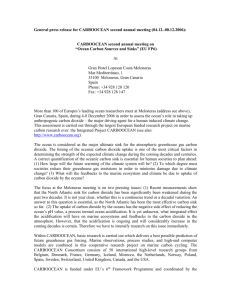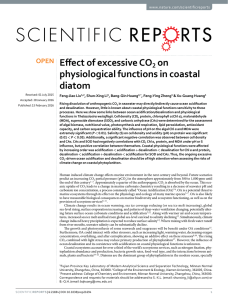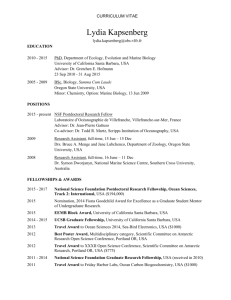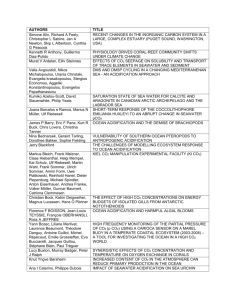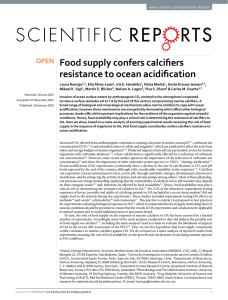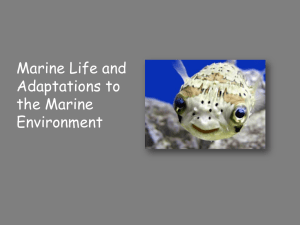ocean acidification
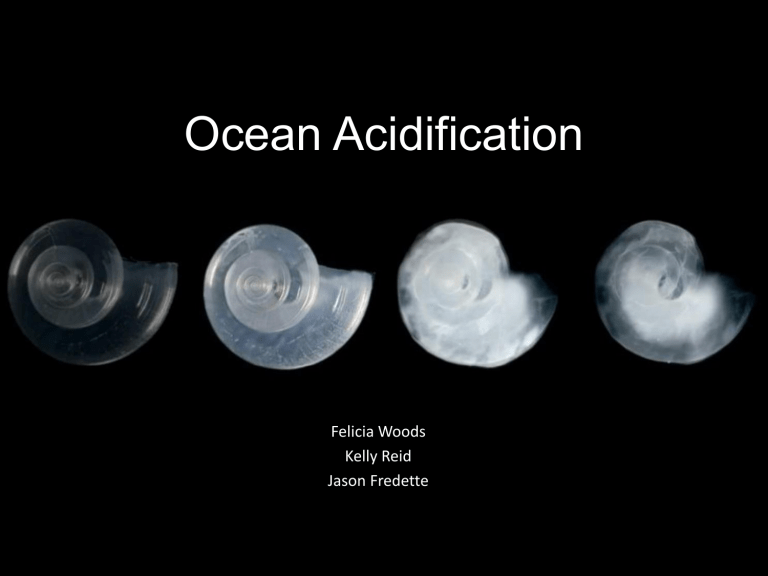
Ocean Acidification
Felicia Woods
Kelly Reid
Jason Fredette
Why should we care?
Ocean acidification is effecting shellfish and other marine organisms by reducing the amount of CaCO
3 in the oceans!
This threatens the existence of a lot of marine species.
How does it effect us?
• Not only do we eat shellfish, a lot of other marine organisms rely on them too, e.g. crustaceans, echinoderms, molluscs, marine mammals, birds, fish…
• The destruction of coral reefs reduces crucial ecosystems.
• Trophic Cascade!
The nature of the environmental problem…
The nature of the problem (con’t)
• Like us, the ocean needs a certain amount of calcium for structure and support.
• The lower pH is corrosive to many marine organisms
• Inhibits growth: Corals, Coralline algae, phytoplankton…
• Reduces calcification rate of corals
• Reduces capacity to transport oxygen
• Impacts food web dynamics and ecosystem functions
What is the cause of the problem?!
What is the cause of the problem?
• Atmospheric CO
2 years is 100 ppm more than it has been in 400,000
– Due to fossil fuel combustion and deforestation
• These human behaviors are increasing the amount of CO
2 in the atmosphere that would otherwise not make it there for a very long time.
1950…………………………………………………….…..2020
What is the cause of the problem?
• Air-sea exchange is always trying to reach equilibrium, so more CO in the ocean
2 in atmosphere means more dissolved CO
2
• Once absorbed, the CO
2 carbonic acid (H
2
CO
3 reacts with water to form
) which then dissociates in to H ions and carbonate and bicarbonate ions.
+
• The increase in H + ions cause the water to become more acidic.
• The increase of H + ions also results in a decrease in carbonate ions, which negatively affects the calcifying organisms.
What does this mean?!
In a nutshell…
• Experiment set up to determine the effect of higher pCO
2 on barnacles:
Pteropods
A NOAA-led research team has found the first evidence that acidity of continental shelf waters off the West Coast is dissolving the shells of tiny free-swimming marine snails, called pteropods, which provide food for pink salmon, mackerel and herring.
Bottom Up Trophic Cascade
“Acidification of our oceans may impact marine ecosystems in a way that threatens the sustainability of the marine resources we depend on,” said Libby Jewett, Director of the NOAA Ocean Acidification
Program .
Coral Reefs
Parrotfish
Ecosystem Engineers http://www.youtube.com/watch?v=7nm-t3ZpFGU
How to remediate the problem?
• We must reduce carbon emissions into the atmosphere.
– National, State and local governments must regulate the amount of CO
2 emissions by human activities.
• Zoning and permitting in areas to reduce direct and indirect sources of CO
2
.
– For example; limit the amount of driving/vehicle miles traveled for individuals in a certain area.
– Indirect: reduce deforestation by limiting the amount of trees that may be cut down.
• Global cap on carbon emissions. Countries must emit less than a set limit and will be fined if they exceed or rewarded if they stay below it.
• Return crushed shell material to ecosystems can increase pH and facilitate shell growth in calcifying organisms.
References
•
•
•
•
•
•
•
•
•
•
•
•
•
•
•
•
•
•
Doney, S., Fabrey, V., et al. (2009). Ocean Acidification: The Other CO2 Problem. Annual Review of Marine Science 1: 169-192. DOI: 10.1146/ annurev.marine.010908.163834
Fabry, V., Seibel, B., Feely, R., & Orr, J. (2008). Impacts Of Ocean Acidification On Marine Fauna And Ecosystem Processes. ICES Journal of Marine
Science 65: 414-432.
Feely, R. A., et al. (2004). Impact Of Anthropogenic CO2 On The CaCO3 System In The Oceans. Science, 305, 362-366.
Kato, A., Hikami, M., Kumagai, N. H., Suzuki, A., & Nojiri, Y. (2014). Negative effects of ocean acidification on two crustose coralline species using genetically homogeneous samples, 94, 1–6.
Kelly, P., Foley, M., et al. (2011). Mitigating Local Causes of Ocean Acidification with Excisting Laws. Policy Forum 332: 1036-1037. http://westcoastoah.org/wp-content/uploads/2013/12/OA-Science-2011-Kelly-1036-7-1.pdf
Orr, J. C, et al. (2005). Anthropogenic ocean acidification over the twenty-first century and its impact on calcifying organisms. . Nature, 437, 681-686
Pansch, C., Schaub, I., Havenhand, J., & Wahl, M. (2013). Habitat traits and food availability determine the response of marine invertebrates to ocean acidification. Global Change Biology, 20: 765-777.
https://confluence.furman.edu:8443/display/Lipscomb/Ocean+Acidification+(EW ) https://www.whoi.edu/main/topic/ocean-acidification http://topologicoceans.wordpress.com/2010/10/04/ocean-acidification-a-primer/ http://www.tripadvisor.com/LocationPhotoDirectLink-g60623-d1918638-i29903336-Mauna_Loa_Helicopters_Private_Tours-
Lihue_Kauai_Hawaii.html
http://www.oceanacidification.org.uk
http://sites.duke.edu/biology217_01_s2011_pv24/files/2011/04/coral-bleaching_pic.jpg
http://dhoffner.files.wordpress.com/2010/07/17-parrot-fish.jpg
http://www.rieschphoto.com/bonaire2008/h3EA45611#h3ea45611 http://www.reefresilience.org/Toolkit_Coral/Stressors/Stressors_OceanAcid_SocialImpacts.html
http://seattletimes.com/html/localnews/2019765681_pteropods26m.html
http://www.noaanews.noaa.gov/stories2014/20140430_oceanacidification.html

